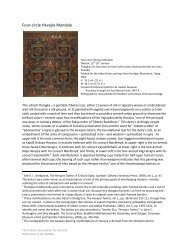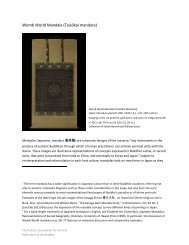Reflections of the Buddha - The Pulitzer Foundation for the Arts
Reflections of the Buddha - The Pulitzer Foundation for the Arts
Reflections of the Buddha - The Pulitzer Foundation for the Arts
You also want an ePaper? Increase the reach of your titles
YUMPU automatically turns print PDFs into web optimized ePapers that Google loves.
in nature is also in one’s mind . . . This kind <strong>of</strong> teaching has been<br />
continuous in Japanese Buddhism since <strong>the</strong> periods <strong>of</strong> Kūkai [774<br />
– 835] and Shinran [1173 – 1263]. Without realizing this, people<br />
make voyages to [distant places] in search <strong>of</strong> self, but god was not<br />
<strong>the</strong>re . . . Returning from <strong>the</strong>ir trips, <strong>the</strong>y realized that god existed<br />
in <strong>the</strong>ir mind. I think what is important here is not only <strong>the</strong><br />
awakening itself, but also <strong>the</strong> journey to this awakening. 17<br />
For Buddhists, <strong>the</strong> journey to awakening, or Nirvāna, begins<br />
with <strong>the</strong> understanding that <strong>the</strong> world’s constituents,<br />
including ourselves, are impermanent, dissatisfactory,<br />
without a concrete self (“no-self”), and conditional (dependent<br />
arising). By experiencing <strong>the</strong>se pre-modern<br />
Buddhist works in Andō’s spaces, <strong>the</strong> visitor to this<br />
<strong>Pulitzer</strong> exhibition may also appreciate <strong>the</strong>se ideas in<br />
new ways.<br />
Impermanence<br />
Andō imparts rich meaning into <strong>the</strong> <strong>Pulitzer</strong>’s spaces by<br />
allowing elements such as light and water to be part <strong>of</strong><br />
<strong>the</strong> experience; <strong>the</strong>y help mark <strong>the</strong> passing <strong>of</strong> time and<br />
<strong>the</strong> changing <strong>of</strong> seasons. 18 This state <strong>of</strong> flux connects with<br />
Buddhist concepts <strong>of</strong> impermanence: Everything arises,<br />
exists in a state <strong>of</strong> constant change, and <strong>the</strong>n passes away.<br />
<strong>The</strong> <strong>Pulitzer</strong>’s glass walls along <strong>the</strong> water garden<br />
allow sunlight into <strong>the</strong> galleries and passageways.<br />
Wind creates movement across <strong>the</strong> water’s surface. On<br />
bright days, <strong>the</strong> sun glistens and reflects light <strong>of</strong>f <strong>the</strong> water,<br />
casting lively rippling patterns onto <strong>the</strong> building’s<br />
ceilings, floors, and walls, a metaphor <strong>for</strong> light’s boundlessness.<br />
<strong>The</strong> visitor who arrives on a stormy day with<br />
dark skies and rain (sometimes in <strong>the</strong> <strong>for</strong>m <strong>of</strong> torrential<br />
sheets that course across <strong>the</strong> water garden’s exterior<br />
walls) looks out and feels a sense <strong>of</strong> awe and <strong>for</strong>eboding<br />
from inside <strong>the</strong> galleries. This constantly changing light<br />
also progresses across <strong>the</strong> surfaces <strong>of</strong> <strong>the</strong> artworks; it animates<br />
<strong>the</strong>m, not unlike <strong>the</strong> natural light and candlelight<br />
that once moved and flickered across <strong>the</strong> statues at <strong>the</strong>ir<br />
original sites.<br />
Andō has written about how light and <strong>for</strong>m are<br />
interrelated:<br />
Light isolated within architectural space lingers on <strong>the</strong> surfaces <strong>of</strong><br />
objects and evokes shadows from <strong>the</strong> background. As light varies<br />
in intensity with <strong>the</strong> shifting <strong>of</strong> time and changes <strong>of</strong> season, <strong>the</strong><br />
appearances <strong>of</strong> objects are altered. But light does not become objectified<br />
and is not itself given <strong>for</strong>m until it is isolated and<br />
accepted by physical objects. 19<br />
When natural light is muted, s<strong>of</strong>t, and indirect at <strong>the</strong><br />
<strong>Pulitzer</strong>, it gives a sculpture like <strong>the</strong> one <strong>of</strong> Prince<br />
Shōtoku (no. 1) even greater volume and adds to <strong>the</strong> lifelike<br />
qualities <strong>of</strong> <strong>the</strong> baby image, especially around his s<strong>of</strong>t<br />
belly and rounded shoulders.<br />
<strong>The</strong> Buddhist idea <strong>of</strong> impermanence is expressed<br />
at <strong>the</strong> <strong>Pulitzer</strong> not just by <strong>the</strong> building’s<br />
constantly changing light but also by <strong>the</strong> simple fact that<br />
<strong>the</strong> art included in this exhibition has itself undergone<br />
12<br />
great change: <strong>the</strong> sculptures are dented, abraded, fragmented.<br />
A head is all that survives <strong>of</strong> a monumental<br />
<strong>Buddha</strong> from Afghanistan (no. 8); a hand, twenty-six inches<br />
long and once belonging to a <strong>Buddha</strong> Amitābha, is one<br />
<strong>of</strong> <strong>the</strong> few remnants from a colossal sculptural triad in<br />
Japan (no. 2). All <strong>of</strong> <strong>the</strong> Buddhist works in <strong>the</strong> exhibition<br />
attest to <strong>the</strong> ravages <strong>of</strong> time. <strong>The</strong>y are no longer in <strong>the</strong>ir<br />
original context, no longer standing among hundreds <strong>of</strong><br />
o<strong>the</strong>r sculptures on a Tibetan altar or among sculptural<br />
groups in Chinese temples. Time has all but rubbed <strong>of</strong>f<br />
<strong>the</strong>ir colorful paint and glistening gold. Today, Buddhists<br />
rarely pray be<strong>for</strong>e <strong>the</strong>se sacred objects, which are now<br />
placed within <strong>the</strong> <strong>Pulitzer</strong>, a contemporary building with<br />
little adornment and constantly changing light. <strong>The</strong> mutability<br />
<strong>of</strong> sky, place, object, and <strong>the</strong> visitor’s own state <strong>of</strong><br />
mind heightens this sense that everything arises, constantly<br />
changes, <strong>the</strong>n passes away.<br />
Dissatisfactoriness<br />
Impermanence, Buddhists believe, leads to dissatifactoriness<br />
(dukha), which is <strong>of</strong>ten translated as suffering. But<br />
<strong>the</strong> term in Buddhism best connotes <strong>the</strong> condition<br />
caused by an axle hole that is not properly made so that<br />
<strong>the</strong> axle wobbles in a dissatisfactory way. 20 People <strong>of</strong>ten<br />
search <strong>for</strong> happiness in things that do not last, causing<br />
dukha in <strong>the</strong>ir lives. Changing afflicted states <strong>of</strong> mind<br />
also produce dukha, which can lead to such feelings as<br />
hatred, greed, and delusion.<br />
Andō’s philosophy <strong>of</strong> architecture addresses<br />
dukha. In 1984, he wrote about confronting societal<br />
norms:<br />
Once a desire approaches satisfaction, it grows larger and stimulates<br />
o<strong>the</strong>r ambitions. Man enters a never-ending cycle and<br />
becomes dominated by his own excessive desires. What really enriches<br />
an individual’s life in an age such as ours? It is important<br />
to discover what is essential to human life and to consider what<br />
abundance truly means. An architectural space stripped <strong>of</strong> all excess<br />
and composed simply from bare necessities is true and<br />
convincing because it is appropriate and satisfying. Simplification<br />
through <strong>the</strong> elimination <strong>of</strong> all surface decorations, <strong>the</strong> employment<br />
<strong>of</strong> minimal, symmetrical compositions and limited<br />
materials constitutes a challenge to contemporary civilization. 21<br />
Here, Andō not only critiques contemporary materialism<br />
and consumerism but also espouses Japanese aes<strong>the</strong>tics<br />
derived from Zen Buddhism as an alternative: simplicity,<br />
austerity, modesty, intimacy, and appreciation <strong>of</strong> <strong>the</strong> integrity<br />
<strong>of</strong> natural objects and processes.<br />
Yet <strong>the</strong> objects in this exhibition cover a wide<br />
range <strong>of</strong> Buddhist cultures and sects. Andō’s geometry<br />
and materials seem far removed from <strong>the</strong> philosophies<br />
that lead to <strong>the</strong> making <strong>of</strong> such elaborate works as <strong>the</strong><br />
gilded bodhisattva from Nepal decorated with semi-precious<br />
stones (no. 14) or <strong>the</strong> imperial sūtra from China that<br />
is ornately painted in gold (no. 24). <strong>The</strong>re is even <strong>the</strong><br />
Buddhist deity Vaiśravana (no. 20), who became a Chinese<br />
wealth god, depicted with sumptuously decorated armor.




